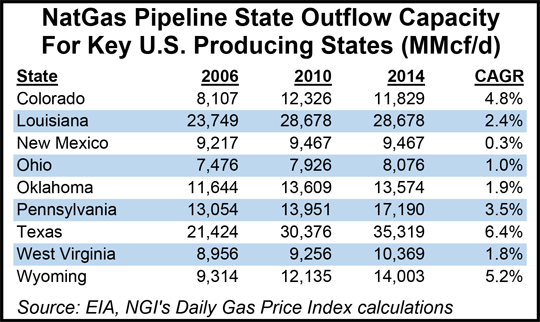Moniz Says Only Regional NatGas Transmission Lines Needed, Alaska LNG Moving Forward
Department of Energy (DOE) Secretary Ernest Moniz said the nation should see construction of a limited number of natural gas transmission lines to meet regional supply needs, rather than a major buildout across the country.

One week after the Obama administration released its Quadrennial Energy Review (QER), Moniz told the Senate Committee on Energy & Natural Resources that the government had found “a substantial buildout” of gas transmission line capacity had taken place over the last decade (see Daily GPI, April 21).
“There is quite a bit of reserve capacity there,” Moniz said Tuesday. “Our conclusion there was that with regard to the natural gas transmission capacity, we’re not looking at a need for a major kind of national, big buildout from what we have. There will be regional needs targeted around specific supply centers.”
Moniz also reassured the committee chair, Sen. Lisa Murkowski (R-AK), that DOE would continue to consider a conditional license for Alaska to export liquefied natural gas (LNG). Early reports for the Alaska LNG pipeline and gas liquefaction/export terminal project, which is estimated to cost $60-65 billion, were filed in February with the Federal Energy Regulatory Commission (see Daily GPI, Feb. 11).
“We view monetizing the natural gas in Alaska as a very different proposition from that in the Lower 48,” Moniz said. “The costs are enormous to move it to an export facility. We are looking at this in a separate way.
“We have already approved the free trade agreement [FTA] part [see Daily GPI, Nov. 21, 2014]. We are actively looking at the non-FTA part for a conditional approval. It’s different from our Lower 48 approach, but the special factors merit that, and we are following through on that.”
During the hearing, Murkowski also raised concern over the current ban on U.S. crude oil exports.
“As we are talking about energy infrastructure and policies for the country going forward, we need to be looking at some of the antiquated policies that we have in place, including the 40-year-old ban on crude oil exports,” Murkowski said.
The QER recommended establishing a competitive program to accelerate pipeline replacement and enhance maintenance programs for gas distribution systems, among other things. An analysis conducted for the QER said the investment in interstate gas pipelines could be $2.6-3.5 billion every year between 2015 and 2030, depending on the overall level of gas demand.
The QER analysis also estimated the total cost for replacing cast iron and bare steel pipes, which are prevalent in local distribution company systems, to be $270 billion.
In a statement, Murkowski’s office said the committee is planning hearings in May to consider proposals for a comprehensive energy bill. Some of the suggestions from the QER could be incorporated into a final bill.
© 2024 Natural Gas Intelligence. All rights reserved.
ISSN © 1532-1231 | ISSN © 2577-9877 | ISSN © 1532-1266 |
